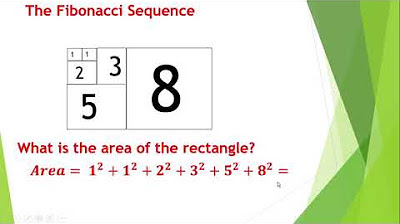THE FIBONACCI SEQUENCE AND THE GOLDEN RATIO || MATHEMATICS IN THE MODERN WORLD
Summary
TLDRThis video script explores the Fibonacci sequence, a series of numbers where each term is the sum of the two preceding ones, starting from one. Leonardo of Pisa, known as Fibonacci, introduced the sequence through a rabbit reproduction problem. The script delves into the sequence's prevalence in nature, such as in the spiral patterns of sunflowers and pinecones, and its relation to the golden ratio, approximately 1.618. It also demonstrates how to calculate terms in the sequence, concluding with an example to find the 15th term, which is 610.
Takeaways
- 📚 Lesson One focused on nature and patterns, while Lesson Two introduced the Fibonacci sequence.
- 🔢 Leonardo Pisano, known as Fibonacci, was a prominent European mathematician of the Middle Ages, credited with introducing the Arabic numeral system to Europe.
- 🐰 The Fibonacci sequence was discovered through an investigation into the reproduction of rabbits, where each new pair of rabbits produces another pair.
- 🌱 The sequence starts with two ones and each subsequent number is the sum of the two preceding ones, forming a pattern like 1, 1, 2, 3, 5, 8, 13, and so on.
- 📈 The Fibonacci sequence can be used to predict the number of rabbit pairs after a given number of months, with 144 pairs after one year in the example provided.
- 🌻 The Fibonacci sequence is observed in nature, such as the spiral structure of sunflowers and the arrangement of pinecones.
- 🌺 The number of petals in many flowers is often a Fibonacci number, and this can also be seen in the structure of fruits like pineapples.
- 🎨 The golden ratio, approximately 1.618, is closely related to the Fibonacci sequence and is often found in art and architecture, including the Mona Lisa.
- 🔍 The golden ratio can be expressed using the formula \( a \over b = (a + b) \over a \), where \( a \) and \( b \) are consecutive Fibonacci numbers.
- 📝 To find a specific term in the Fibonacci sequence, you start with the first two terms as one and continue by adding the last two terms to get the next one.
- 👋 The video concludes by encouraging viewers to like, subscribe, and hit the bell for more educational content.
Q & A
Who is Leonardo Pisano, also known as Fibonacci?
-Leonardo Pisano, nicknamed Fibonacci, was the greatest European mathematician of the Middle Ages, born in 1170 and died in 1240. He is known for introducing the Arabic number system to Europe.
What is the origin of the Fibonacci sequence?
-The Fibonacci sequence was discovered after an investigation on the reproduction of rabbits. It represents the number of rabbit pairs in a field over a period of time, assuming a constant rate of reproduction.
How is the Fibonacci sequence defined mathematically?
-The Fibonacci sequence is an infinite series of numbers where each number after the first two is the sum of the two preceding ones. It starts with 1, 1, and then follows with 2, 3, 5, 8, 13, and so on.
What is the significance of the Fibonacci sequence in nature?
-The Fibonacci sequence is observed in nature in various forms, such as the spiral structure of sunflowers and pine cones, the arrangement of petals in flowers, and the pattern of pineapple crowns.
How many rabbit pairs would there be at the end of one year according to the Fibonacci sequence?
-According to the script's illustration, there would be 144 pairs of rabbits at the end of one year if the sequence follows the Fibonacci pattern.
What is the golden ratio and how is it related to the Fibonacci sequence?
-The golden ratio, often denoted by the Greek letter phi (φ), is approximately equal to 1.618. It is related to the Fibonacci sequence as the ratio between successive Fibonacci numbers converges to the golden ratio.
Can the golden ratio be found in art and architecture?
-Yes, the golden ratio is often found in art and architecture, believed to provide aesthetically pleasing proportions, such as in the structure of the Mona Lisa.
How can one find the 9th term of the Fibonacci sequence?
-To find the 9th term of the Fibonacci sequence, start with the first two terms as 1 and 1, then continue adding the last two terms to get the next term, resulting in 34 as the 9th term.
What is the 15th term of the Fibonacci sequence?
-Following the pattern of the Fibonacci sequence, the 15th term is 610.
Do plants perform mathematical calculations?
-Plants do not perform mathematical calculations, but their growth patterns often follow the Fibonacci sequence, which is a result of natural processes.
Outlines

Dieser Bereich ist nur für Premium-Benutzer verfügbar. Bitte führen Sie ein Upgrade durch, um auf diesen Abschnitt zuzugreifen.
Upgrade durchführenMindmap

Dieser Bereich ist nur für Premium-Benutzer verfügbar. Bitte führen Sie ein Upgrade durch, um auf diesen Abschnitt zuzugreifen.
Upgrade durchführenKeywords

Dieser Bereich ist nur für Premium-Benutzer verfügbar. Bitte führen Sie ein Upgrade durch, um auf diesen Abschnitt zuzugreifen.
Upgrade durchführenHighlights

Dieser Bereich ist nur für Premium-Benutzer verfügbar. Bitte führen Sie ein Upgrade durch, um auf diesen Abschnitt zuzugreifen.
Upgrade durchführenTranscripts

Dieser Bereich ist nur für Premium-Benutzer verfügbar. Bitte führen Sie ein Upgrade durch, um auf diesen Abschnitt zuzugreifen.
Upgrade durchführen5.0 / 5 (0 votes)






